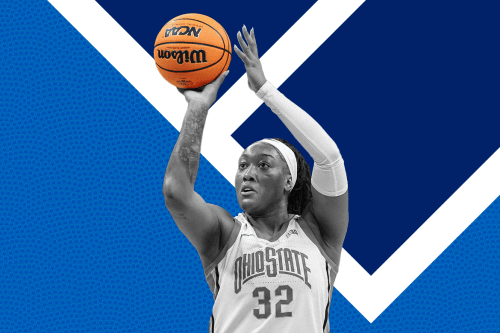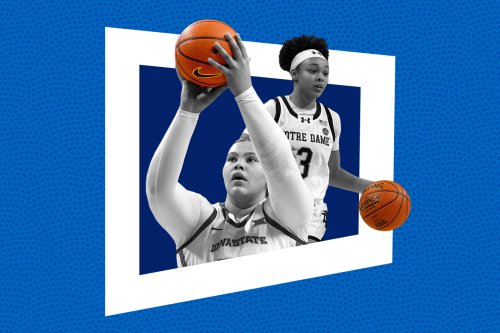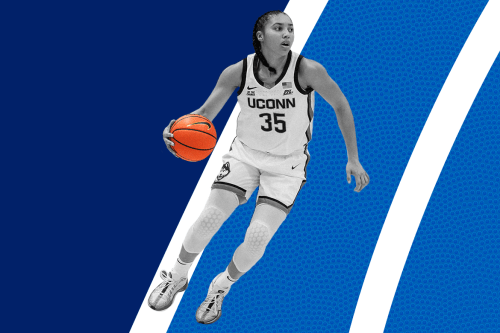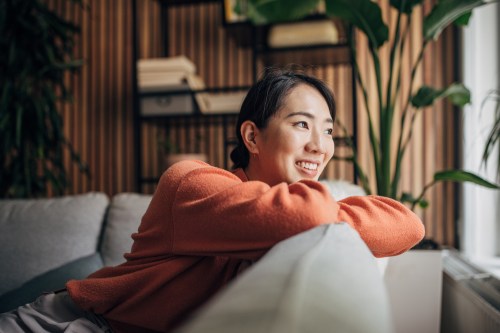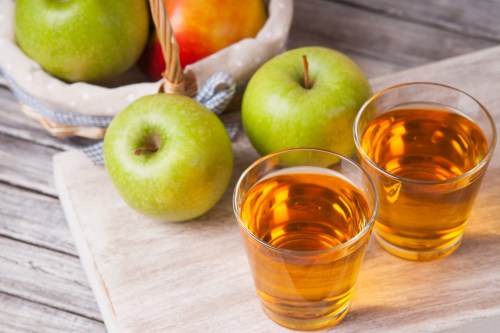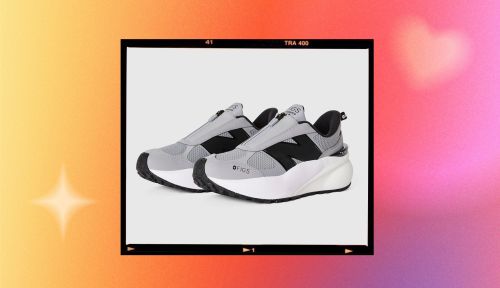Tennis isn’t just a sport we love to watch on TV—it’s a wildly effective workout that requires endurance, agility, and speed. It’s been linked with benefits like lower obesity rates, reduced incidence of heart disease, and overall improved health, per a 2020 study in the International Journal of Exercise Science1.
Experts in This Article
Life Time tennis leader and coach
an orthopedic surgeon at NewYork-Presbyterian/Columbia University Irving Medical Center
“Tennis is a fantastic full-body workout and is great for cardiovascular fitness and longevity,” says Life Time tennis leader and coach Gordon Reid.
However, becoming a great tennis player doesn’t just happen when you’re serving balls. If you want to truly crush your next tennis match, it’s important to do off-court tennis training exercises that strengthen the areas of your body that are targeted most during the game.
“Practicing a tennis-specific strength and mobility routine outside of the court just a couple times a week can boost your on-court performance and help reduce the chance of common joint and soft tissue injuries, like tennis elbow,” Reid says.
Getting fit for tennis
When doing off-court tennis training exercises to level up your tennis game, focus on these key areas to prepare your body (and mind!) for success.
1. Tissue tolerance
First, you need to prime your body to avoid injury, which can otherwise quickly derail your tennis game.
The most commonly injured area in tennis is the shoulder (22 percent), followed by the elbow (19 percent), ankle (17 percent), wrist (16 percent), and knee (12 percent), per a 2023 study on adolescent tennis players in the Turkish Journal of Sports Medicine2.
“Include specific prehabilitation exercises targeting common tennis injuries, such as rotator cuff strengthening for shoulder stability and eccentric exercises for the Achilles tendon,” Reid says.
Also be mindful of how quickly you amp up your tennis practice. You should gradually increase the volume and intensity of your tennis games to give your body the chance to adapt.
2. Endurance and mental toughness
To be a successful tennis player, you need to not hold up physically and mentally. Practice building up your cardiovascular health with cross-training, like running, cycling, and swimming.
“You might also consider high-intensity interval training (HIIT), which can mimic the stop-and-go nature of tennis matches,” Reid says.
Meanwhile, prepare for a match by simulating game conditions that build your mental toughness.
“Practice specific skills, such as serving under pressure or playing tie-breakers, to prepare for high-stress situations in matches,” Reid says.
3. Resistance training focused on rotational strength
In particular, focus on exercises that improve rotational strength and power, such as medicine ball throws and woodchoppers. Rotational strength is crucial for powerful strokes, Reid says.
For overall strength, focus on compound movements like deadlifts and bench presses.
You can also incorporate resistance bands into your strength training to build muscles with a 360-degree approach.
“When you’re serving tennis balls, you need different types of strength in different muscle fibers.”—Melvin Rosenwasser, MD
“This works the muscle in both directions, which builds a more coordinated type of strength,” says Melvin Rosenwasser, MD, an orthopedic surgeon at NewYork-Presbyterian/Columbia University Irving Medical Center. “When you’re serving tennis balls, for instance, you need different types of strength in different muscle fibers.”
4. Dynamic and static stretching
Stretching is a functional component of movement and can help increase your flexibility, lower the risk of injury, prevent muscle soreness, and improve performance in your game, per the International Tennis Federation (ITF).
Dynamic stretching refers to moving parts of your body to gradually increase reach or speed of movement, which can help increase muscle temperature and blood flow. These stretches can include leg swings, arm circles, and torso twists, Reid says.
Static stretching involves slowly and gently stretching the muscle to the point of slight discomfort and then holding for 15 to 30 seconds, which helps to increase the range of motion in your joints and the flexibility of your target muscle. Tennis players should aim to do static stretching twice per day, particularly after exercise or in the evenings, per the ITF.
“For static stretching post-tennis, focus on muscles that are heavily used during play, such as the hamstrings, calves, shoulders, and forearms,” Reid says.
5. Agility and speed
Tennis involves quick reactions, which you can practice in your off-court tennis training exercises.
“Incorporate plyometric exercises like box jumps and jump squats to improve explosive power,” Reid says.
You can also use reaction drills with a partner or coach to enhance your reflexes and quick decision-making on the court. These might include mirror drills (copy your partner’s movements as quickly as possible) or a simple game of catch and toss (throw a ball back and forth at various speeds and heights).
Finally, something as simple as sprints can help you build up the speed to effectively move across the court.
“Create a marked distance that’s compatible with a tennis court—say, 20 or 25 feet—and run from line to line,” Dr. Rosenwasser says. “Also do side-to-side movements where you’re shuffling your left foot over your right, and back. That’s the kind of movement you need to be able to get to the balls and return them.”
6 off-court tennis training exercises you can do anywhere
This workout is designed by Life Time personal trainer and tennis specialist Joe Meier, CPT, and demonstrated by Reid. It will improve your tennis game by boosting strength and mobility, while also preventing injury.
Complete two to three sets of 10 to 15 reps for each exercise, two to three times per week.
“It’s a great workout for off days from tennis or as a pregame warmup,” Reid says.
1. Standing shoulder external rotation with anchored resistance
This exercise will strengthen your shoulder stability, which is crucial for strokes when playing tennis.
Set-up
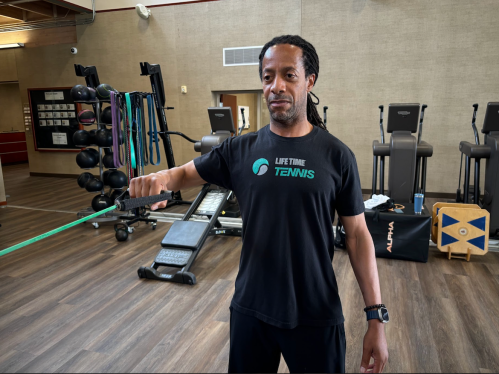
- 1.Stand tall with your feet shoulder-width apart.
- 2.Hold a band anchored at shoulder height with your right hand. Keep your left arm down by your side.
- 3.Step back to create tension in the band.
Movement
Gold Medal Couple Tara Davis-Woodhall and Hunter Woodhall Talk Marriage, Motivation, and Their Next Chapter With Nike

Coach Kara Lawson Wants You to ‘Handle Hard Better’—and Here Are 3 Ways to Do Just That

JuJu Watkins Leaves March Madness With ACL Tear—and This Knee Injury Is More Common Than You Think


- 1.Raise your right elbow to shoulder height, maintaining a 90-degree angle.
- 2.Rotate your right hand and forearm backward against the band’s resistance, then forward. Keep your elbow still, pivoting your hand and forearm. Avoid shrugging your shoulder or turning your trunk.
- 3.Repeat on the opposite side.
2. Single-arm overhead triceps extension
With this move, you’ll enhance your serving shoulder’s range of motion, mimicking the “hitting up” motion that you make while serving.
Set-up

- 1.Stand upright with your feet shoulder-width apart, arms down by your sides. Hold a dumbbell in your right hand, palms facing in.
- 2.Raise your right arm straight up in the air so that your right bicep is next to your right ear.
Movement

- 1.Keeping your right elbow still, lower your right hand behind your head, simulating the racket drop of a serve.
- 2.Keep your right elbow still, reach your hand back up toward the ceiling, and work your triceps.
- 3.Perform the movement slowly and controlled.
- 4.Repeat with the other arm.
3. Star lunge
Use this move to target your hips and lower body, improving the multi-directional movement that’s essential for tennis.
Set-up

- 1.Stand upright with your feet shoulder-width apart, arms down by your sides.
- 2.Extend your left leg out in front of you and place your left heel on the ground.
Movement
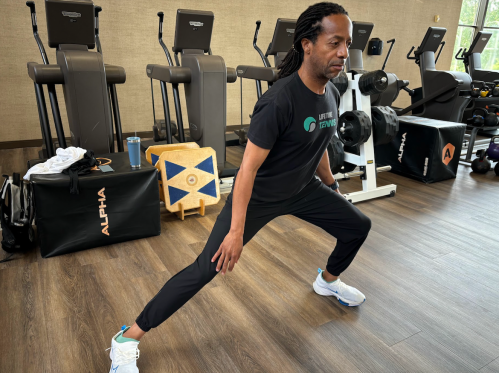
- 1.Drop down into a lunge with your left leg in front.
- 2.Return to the starting position.
- 3.Lunge to the side, then return.
- 4.Lunge backward, then return.
- 5.Switch legs and repeat. Start slowly, then build to more explosive motions.
4. Pallof press
This is a great exercise to build core strength and stability between the lower and upper body—key to building your tennis game.
Set-up

- 1.Use a cable system or a band anchored at chest height.
- 2.Stand with the anchor to your left side.
- 3.Grab the band or pulley handle with your left hand and pull it close to your chest. Place your right hand on top of your left hand.
- 4.Step laterally away from the anchor for resistance. Make sure your feet are about shoulder-width apart and slightly bent.
Movement
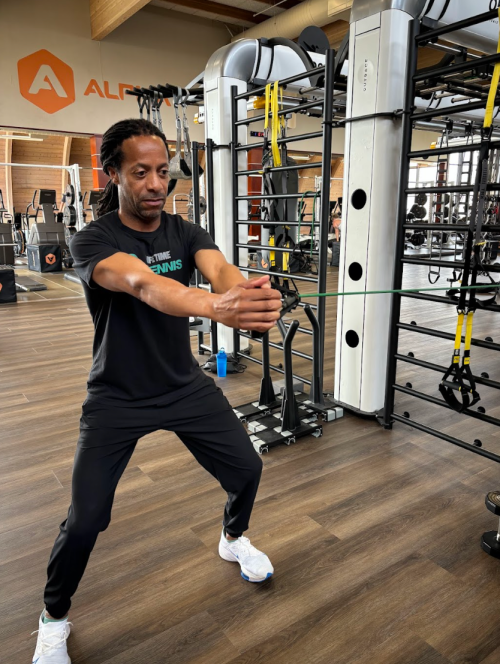
- 1.Push your arms straight out in front of you, then pull back in, resisting rotation.
- 2.Repeat with the anchor on the other side.
5. Squat and reach
Activate your core, back, and shoulder muscles with this full-body stretch. All of these areas are essential while playing a racket sport like tennis.
Set-up and movement

- 1.Stand with feet shoulder-width apart and squat down, hands touching the floor, elbows inside your knees.
- 2.Staying in a squat, push your left elbow out and reach your right hand up toward the sky.
- 3.Follow your reaching hand with your gaze.
- 4.Place your right hand back on the floor and stand up out of your squat.
- 5.Repeat on the opposite side, standing up between reps.
6. Tennis elbow prevention exercise
Avoid tennis elbow by strengthening your forearm tendons with this exercise.
Set-up

- 1.Sit or stand anywhere you can extend your wrist and have full range of motion.
- 2.Extend your arm out in front of you with a slight bend in your elbow, palm facing down.
Movement
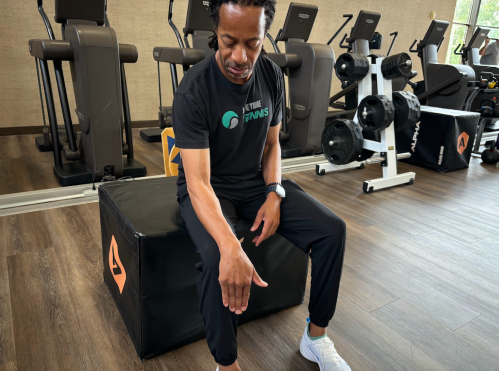
- 1.Flex and extend your wrist (without moving the rest of your arm) to engage your forearm muscles.
- 2.Repeat with your palm facing up to work the flexors.
- 3.Perform with your other arm.
TIP
As you build up strength, you can add a light weight for more resistance.
Spring KE, Holmes ME, Smith JW. Long-term Tennis Participation and Health Outcomes: An Investigation of “Lifetime” Activities. Int J Exerc Sci. 2020 Sep 1;13(7):1251-1261. PMID: 33042385; PMCID: PMC7523898.
↩︎Abdioglu M, Guler M, Mor A, Harput G. Adolescent tennis players’ injury profile and awareness level of sports injury. Turk J Sports Med. 2023; 58(3):133- 8; https://doi.org/10.47447/tjsm.0759
↩︎
Sign Up for Our Daily Newsletter
Get all the latest in wellness, trends, food, fitness, beauty, and more delivered right to your inbox.
Got it, you've been added to our email list.

